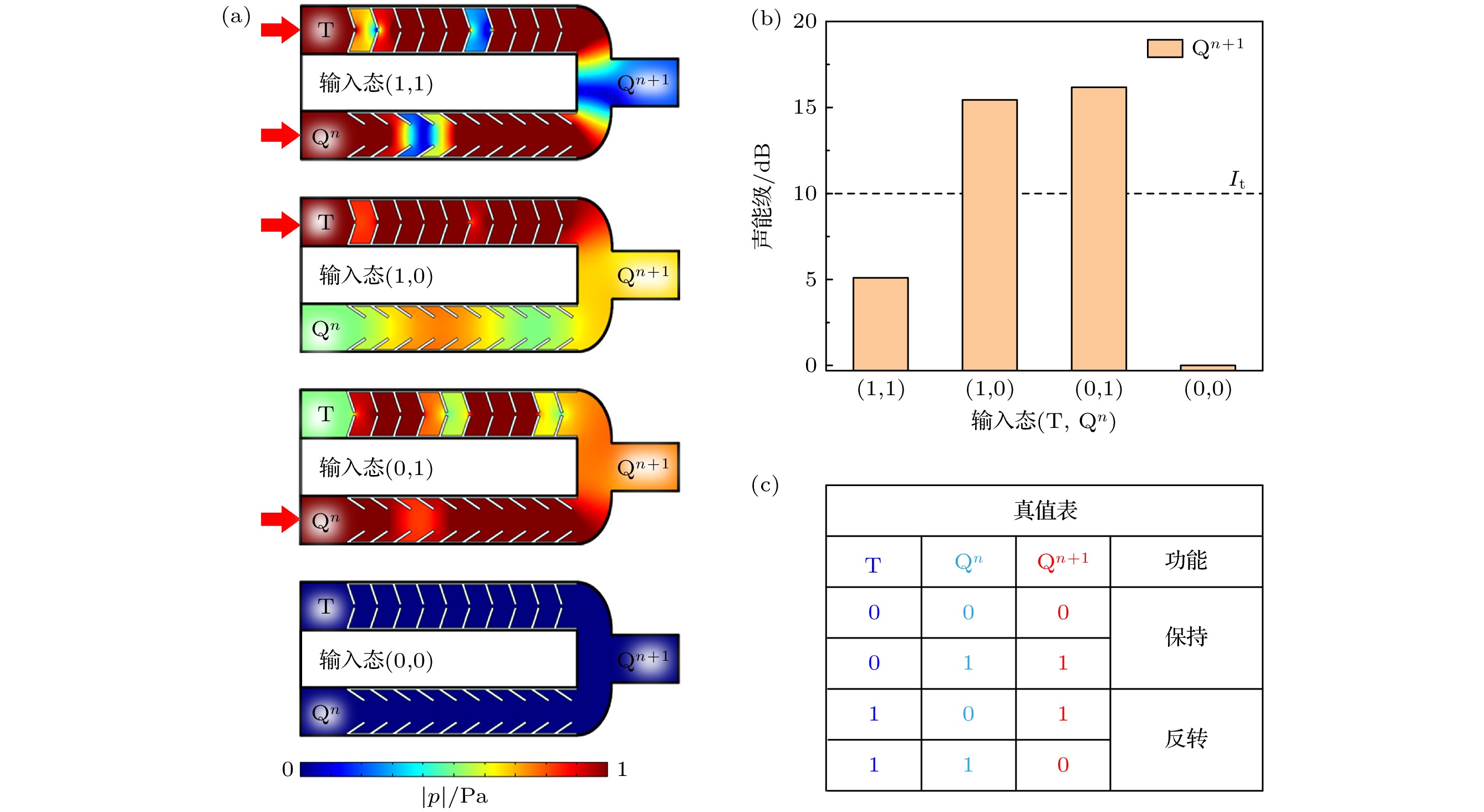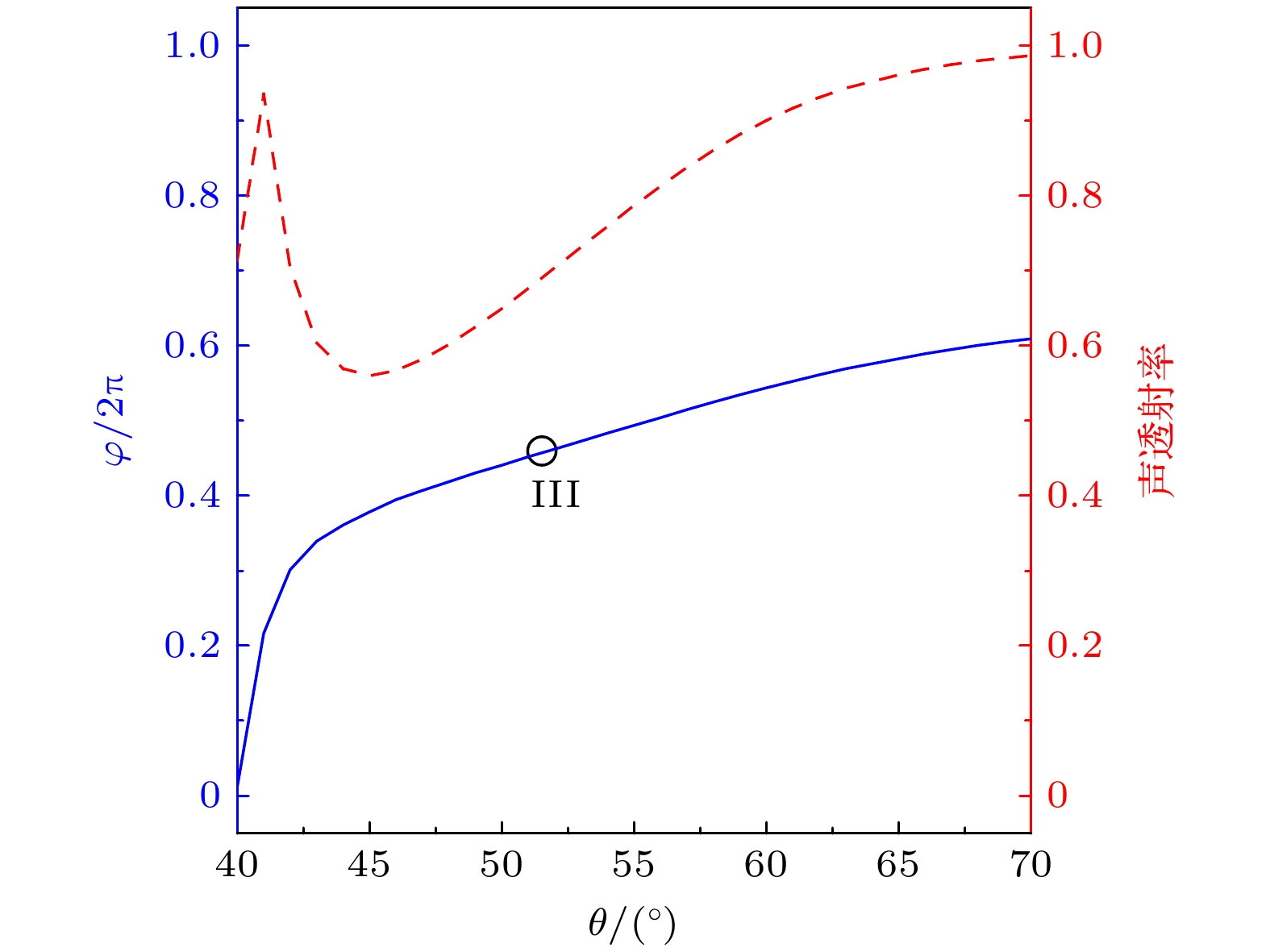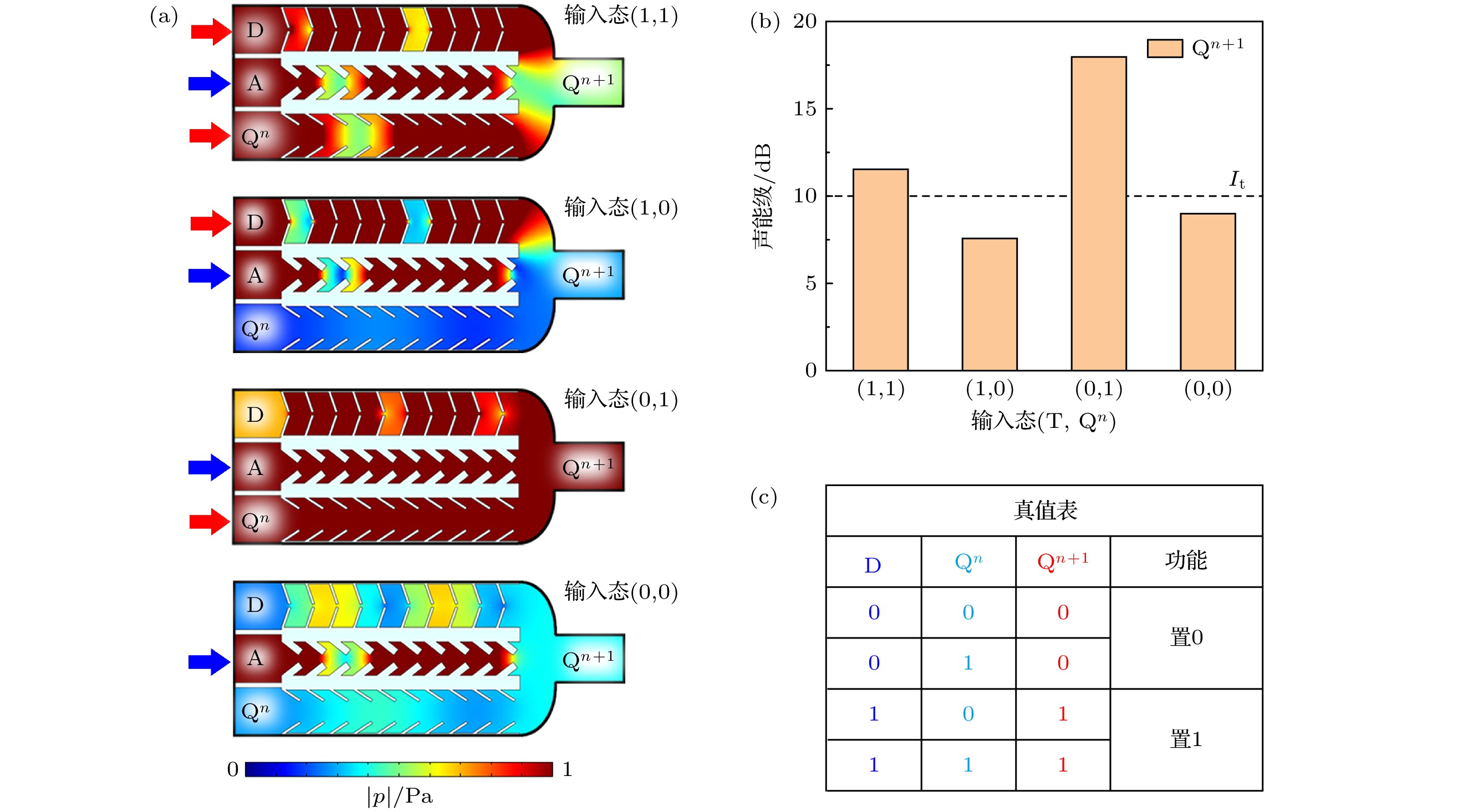-
The study of acoustic information processing has attracted great attention owing to its advantages of anti-electromagnetic interference and low energy consumption. Acoustic logic device, as a fundamental component, plays an important role in designing integrated acoustic systems. In the past few years, with the rapid development of sonic crystals, acoustic metamaterials and metasurfaces, researchers have demonstrated a variety of acoustic logic gates based on different mechanisms, and have devoted their efforts to the promotion of the practical applications. The more complex acoustic triggers with broad bandwidth and subwavelength size are very important for developing integrated sound devices, but it is difficult to realize them. In this work, we design two types of acoustic triggers based on the mechanisms of linear interference and phase modulation. The acoustic trigger with a width of 0.32λ and length of 0.82λ is composed of phased unit cells and multi-port waveguide structures, showing a subwavelength structure. Based on the phase modulation of the phased unit cells and the mechanism of linear interferences, the acoustic T-type trigger and D-type trigger with the same threshold are designed and demonstrated experimentally. The corresponding working bands of the T-type and D-type triggers are 3.293–4.069 kHz and 3.400–4.138 kHz, and their fractional bandwidths (the ratio of the bandwidth to the center frequency) can reach about 0.23 and 0.22, respectively, showing a broadband characteristic of both triggers. The mechanism of the T-type trigger is attributed to the linear interference caused by two phased unit cells with a phase difference of π. However, the realization of the D-type trigger is closely related to the incident sound energy and the phase modulation caused by the phased unit cell in the control port. The measured results and simulated results agree well with each other. Compared with other types of acoustic logic devices, the designed acoustic triggers have the advantages of broad bandwidth, subwavelength size, same threshold, and passive structure, as well as being easy to integrate, thus providing great potential applications in acoustic computing, acoustic communication, acoustic information processing and integrated acoustics. Our experimental demonstration of acoustic triggers can further promote the theoretical and experimental investigations of basic acoustic components.
-
Keywords:
- acoustic metamaterials /
- acoustic trigger /
- phase modulation /
- linear interference /
- waveguide
[1] Liang B, Guo X S, Tu J, Zhang D, Cheng J C 2010 Nat. Mater. 9 989
 Google Scholar
Google Scholar
[2] Li X F, Ni X, Feng L, Lu M H, He C, Chen Y F 2011 Phys. Rev. Lett. 106 084301
 Google Scholar
Google Scholar
[3] Liang B, Kan W, Zou X, Yin L, Cheng J 2014 Appl. Phys. Lett. 105 083510
 Google Scholar
Google Scholar
[4] Babaee S, Viard N, Wang P, Fang N X, Bertoldi K 2016 Adv. Mater. 28 1631
 Google Scholar
Google Scholar
[5] Nan T, Lin H, Gao Y, Matyushov A, Yu G, Chen H, Sun N, Wei S, Wang Z, Li M, Wang X, Belkessam A, Guo R, Chen B, Zhou J, Qian Z, Hui Y, Rinaldi M, McConney M E, Howe B M, Hu Z, Jones J G, Brown G J, Sun N X 2017 Nat. Commun. 8 296
 Google Scholar
Google Scholar
[6] Zuo S Y, Wei Q, Tian Y, Cheng Y, Liu X J 2018 Sci. Rep. 8 10103
 Google Scholar
Google Scholar
[7] Wu Y D 2021 Prog. Electromagn. Res. 170 79
 Google Scholar
Google Scholar
[8] Li F, Anzel P, Yang J, Kevrekidis P G, Daraio C 2014 Nat. Commun. 5 5311
 Google Scholar
Google Scholar
[9] Liu Z, Zhang X, Mao Y, Zhu Y Y, Yang Z, Chan C T, Sheng P 2000 Science 289 1734
 Google Scholar
Google Scholar
[10] Lu M H, Zhang C, Feng L, Zhao J, Chen Y F, Mao Y W, Zi J, Zhu Y Y, Zhu S N, Ming N B 2007 Nat. Mater. 6 744
 Google Scholar
Google Scholar
[11] Bringuier S, Swinteck N, Vasseur J O, Robillard J F, Runge K, Muralidharan K, Deymier P A 2011 J. Acoust. Soc. Am. 130 1919
 Google Scholar
Google Scholar
[12] Zhang T, Cheng Y, Guo J Z, Xu J Y, Liu X J 2015 Appl. Phys. Lett. 106 113503
 Google Scholar
Google Scholar
[13] Lu J, Qiu C, Ke M, Liu Z 2016 Phys. Rev. Lett. 116 093901
 Google Scholar
Google Scholar
[14] Xia J P, Jia D, Sun H X, Yuan S Q, Ge Y, Si Q R, Liu X J 2018 Adv. Mater. 30 1805002
 Google Scholar
Google Scholar
[15] Tian Z, Shen C, Li J, Reit E, Bachman H, Socolar J E S, Cummer S A, Huang J 2020 Nat. Commun. 11 762
 Google Scholar
Google Scholar
[16] Jia D, Wang Y, Ge Y, Yuan S Q, Sun H X 2021 Prog. Electromagn. Res. 172 13
 Google Scholar
Google Scholar
[17] Yan Q H, Chen H S, Yang Y H 2021 Prog. Electromagn. Res. 172 33
 Google Scholar
Google Scholar
[18] 李荫铭, 孔鹏, 毕仁贵, 何兆剑, 邓科 2022 物理学报 71 244302
 Google Scholar
Google Scholar
Li Y M, Kong P, Bi R G, He Z J, Deng K 2022 Acta Phys. Sin. 71 244302
 Google Scholar
Google Scholar
[19] Lu Y J, Wang Y, Ge Y, Yuan S Q, Jia D, Sun H X, Liu X J 2022 Appl. Phys. Lett. 121 123506
 Google Scholar
Google Scholar
[20] Li J, Chan C T 2004 Phys. Rev. E 70 055602
 Google Scholar
Google Scholar
[21] Fang N, Xi D, Xu J, Ambati M, Srituravanich W, Sun C, Zhang X 2006 Nat. Mater. 5 452
 Google Scholar
Google Scholar
[22] Li J, Fok L, Yin X, Bartal G, Zhang X 2009 Nat. Mater. 8 931
 Google Scholar
Google Scholar
[23] Lai Y, Wu Y, Sheng P, Zhang Z Q 2011 Nat. Mater. 10 620
 Google Scholar
Google Scholar
[24] Liang Z, Li J 2012 Phys. Rev. Lett. 108 114301
 Google Scholar
Google Scholar
[25] Cheng Y, Zhou C, Yuan B G, Wu D J, Wei Q, Liu X J 2015 Nat. Mater. 14 1013
 Google Scholar
Google Scholar
[26] Cummer S A, Christensen J, Alù A 2016 Nat. Rev. Mater. 1 16001
 Google Scholar
Google Scholar
[27] Zhang T, Cheng Y, Yuan B G, Guo J Z, Liu X J 2016 Appl. Phys. Lett. 108 183508
 Google Scholar
Google Scholar
[28] Zuo C Y, Xia J P, Sun H X, Ge Y, Yuan S Q, Liu X J 2017 Appl. Phys. Lett. 111 243501
 Google Scholar
Google Scholar
[29] Wang Y, Xia J P, Sun H X, Yuan S Q, Liu X J 2019 Sci. Rep. 9 8355
 Google Scholar
Google Scholar
[30] Li Z P, Cao G T, Li C H, Dong S H, Deng Y, Liu X K, Ho J S, Qiu C W 2021 Prog. Electromagn. Res. 171 1
 Google Scholar
Google Scholar
[31] 胥强荣, 沈承, 韩峰, 卢天健 2021 物理学报 70 244302
 Google Scholar
Google Scholar
Xu Q R, Shen C, Han F, Lu T J 2021 Acta Phys. Sin. 70 244302
 Google Scholar
Google Scholar
[32] Liao G X, Wang Z W, Luan C C, Liu J P, Yao X H, Fu J Z 2021 Smart Mater. Struct. 30 045021
 Google Scholar
Google Scholar
[33] Hazra S, Ghosh B, Sarkar P P 2019 J. Opt. 48 375
 Google Scholar
Google Scholar
[34] Bharti G K, Sonkar R K 2022 Opt. Quantum Electron. 54 176
 Google Scholar
Google Scholar
-
图 1 (a) 相控单元示意图; (b) 频率为3.43 kHz的声波通过具有不同参数θ的单元产生的相位延迟与透射率; (c) 声触发器示意图. T和Qn端口的红色箭头表示输入声信号, Qn+1端口的蓝色箭头表示输出声信号
Fig. 1. (a) Schematic of a phased unit cell; (b) phase delays (blue solid line) and transmissions (red dashed line) of sound wave with frequency of 3.43 kHz caused by the phased unit cells with different values of θ; (c) schematic of an acoustic trigger. The red arrows at the ports T and Qn represent input sound signals, and the blue arrows at the port Qn+1 are output sound signals.
图 5 (a) 实验装置示意图; (b), (c) T型与D型触发器样品照片; (d), (e) 实验测量的频率为3.43 kHz的不同输入态声波激发T触发器和D触发器对应输出端Qn+1的声能级
Fig. 5. (a) Schematic of experimental set-up; (b), (c) photographs of the T-type trigger and D-type trigger; (d), (e) experimental measurement of the acoustic intensity levels at the output port Qn+1 of T-type trigger and D-type trigger at a frequency of 3.43 kHz.
图 6 T触发器(a)和D触发器(b)输出端处的不同输入态对应的声能级谱. 黑色阴影区域范围分别为(a) 3.293— 4.069 kHz, (b) 3.400—4.138 kHz
Fig. 6. Measured intensity level spectra at the output ports of the T-type trigger (a) and D-type trigger (b) for different input states. Black shaded regions cover the ranges of 3.293–4.069 kHz in panel (a) and 3.400–4.138 kHz in panel (b).
-
[1] Liang B, Guo X S, Tu J, Zhang D, Cheng J C 2010 Nat. Mater. 9 989
 Google Scholar
Google Scholar
[2] Li X F, Ni X, Feng L, Lu M H, He C, Chen Y F 2011 Phys. Rev. Lett. 106 084301
 Google Scholar
Google Scholar
[3] Liang B, Kan W, Zou X, Yin L, Cheng J 2014 Appl. Phys. Lett. 105 083510
 Google Scholar
Google Scholar
[4] Babaee S, Viard N, Wang P, Fang N X, Bertoldi K 2016 Adv. Mater. 28 1631
 Google Scholar
Google Scholar
[5] Nan T, Lin H, Gao Y, Matyushov A, Yu G, Chen H, Sun N, Wei S, Wang Z, Li M, Wang X, Belkessam A, Guo R, Chen B, Zhou J, Qian Z, Hui Y, Rinaldi M, McConney M E, Howe B M, Hu Z, Jones J G, Brown G J, Sun N X 2017 Nat. Commun. 8 296
 Google Scholar
Google Scholar
[6] Zuo S Y, Wei Q, Tian Y, Cheng Y, Liu X J 2018 Sci. Rep. 8 10103
 Google Scholar
Google Scholar
[7] Wu Y D 2021 Prog. Electromagn. Res. 170 79
 Google Scholar
Google Scholar
[8] Li F, Anzel P, Yang J, Kevrekidis P G, Daraio C 2014 Nat. Commun. 5 5311
 Google Scholar
Google Scholar
[9] Liu Z, Zhang X, Mao Y, Zhu Y Y, Yang Z, Chan C T, Sheng P 2000 Science 289 1734
 Google Scholar
Google Scholar
[10] Lu M H, Zhang C, Feng L, Zhao J, Chen Y F, Mao Y W, Zi J, Zhu Y Y, Zhu S N, Ming N B 2007 Nat. Mater. 6 744
 Google Scholar
Google Scholar
[11] Bringuier S, Swinteck N, Vasseur J O, Robillard J F, Runge K, Muralidharan K, Deymier P A 2011 J. Acoust. Soc. Am. 130 1919
 Google Scholar
Google Scholar
[12] Zhang T, Cheng Y, Guo J Z, Xu J Y, Liu X J 2015 Appl. Phys. Lett. 106 113503
 Google Scholar
Google Scholar
[13] Lu J, Qiu C, Ke M, Liu Z 2016 Phys. Rev. Lett. 116 093901
 Google Scholar
Google Scholar
[14] Xia J P, Jia D, Sun H X, Yuan S Q, Ge Y, Si Q R, Liu X J 2018 Adv. Mater. 30 1805002
 Google Scholar
Google Scholar
[15] Tian Z, Shen C, Li J, Reit E, Bachman H, Socolar J E S, Cummer S A, Huang J 2020 Nat. Commun. 11 762
 Google Scholar
Google Scholar
[16] Jia D, Wang Y, Ge Y, Yuan S Q, Sun H X 2021 Prog. Electromagn. Res. 172 13
 Google Scholar
Google Scholar
[17] Yan Q H, Chen H S, Yang Y H 2021 Prog. Electromagn. Res. 172 33
 Google Scholar
Google Scholar
[18] 李荫铭, 孔鹏, 毕仁贵, 何兆剑, 邓科 2022 物理学报 71 244302
 Google Scholar
Google Scholar
Li Y M, Kong P, Bi R G, He Z J, Deng K 2022 Acta Phys. Sin. 71 244302
 Google Scholar
Google Scholar
[19] Lu Y J, Wang Y, Ge Y, Yuan S Q, Jia D, Sun H X, Liu X J 2022 Appl. Phys. Lett. 121 123506
 Google Scholar
Google Scholar
[20] Li J, Chan C T 2004 Phys. Rev. E 70 055602
 Google Scholar
Google Scholar
[21] Fang N, Xi D, Xu J, Ambati M, Srituravanich W, Sun C, Zhang X 2006 Nat. Mater. 5 452
 Google Scholar
Google Scholar
[22] Li J, Fok L, Yin X, Bartal G, Zhang X 2009 Nat. Mater. 8 931
 Google Scholar
Google Scholar
[23] Lai Y, Wu Y, Sheng P, Zhang Z Q 2011 Nat. Mater. 10 620
 Google Scholar
Google Scholar
[24] Liang Z, Li J 2012 Phys. Rev. Lett. 108 114301
 Google Scholar
Google Scholar
[25] Cheng Y, Zhou C, Yuan B G, Wu D J, Wei Q, Liu X J 2015 Nat. Mater. 14 1013
 Google Scholar
Google Scholar
[26] Cummer S A, Christensen J, Alù A 2016 Nat. Rev. Mater. 1 16001
 Google Scholar
Google Scholar
[27] Zhang T, Cheng Y, Yuan B G, Guo J Z, Liu X J 2016 Appl. Phys. Lett. 108 183508
 Google Scholar
Google Scholar
[28] Zuo C Y, Xia J P, Sun H X, Ge Y, Yuan S Q, Liu X J 2017 Appl. Phys. Lett. 111 243501
 Google Scholar
Google Scholar
[29] Wang Y, Xia J P, Sun H X, Yuan S Q, Liu X J 2019 Sci. Rep. 9 8355
 Google Scholar
Google Scholar
[30] Li Z P, Cao G T, Li C H, Dong S H, Deng Y, Liu X K, Ho J S, Qiu C W 2021 Prog. Electromagn. Res. 171 1
 Google Scholar
Google Scholar
[31] 胥强荣, 沈承, 韩峰, 卢天健 2021 物理学报 70 244302
 Google Scholar
Google Scholar
Xu Q R, Shen C, Han F, Lu T J 2021 Acta Phys. Sin. 70 244302
 Google Scholar
Google Scholar
[32] Liao G X, Wang Z W, Luan C C, Liu J P, Yao X H, Fu J Z 2021 Smart Mater. Struct. 30 045021
 Google Scholar
Google Scholar
[33] Hazra S, Ghosh B, Sarkar P P 2019 J. Opt. 48 375
 Google Scholar
Google Scholar
[34] Bharti G K, Sonkar R K 2022 Opt. Quantum Electron. 54 176
 Google Scholar
Google Scholar
计量
- 文章访问数: 5059
- PDF下载量: 77
- 被引次数: 0














 下载:
下载:





